Ecological and Public Advantages of a Dual Flagship Strategy: Giant Panda and Snow Leopard
Abstract
1. Introduction
2. Method
2.1. Habitat of Species
2.2. Questionnaire Survey
2.3. Data Analysis
3. Result
3.1. Beneficiary Species
3.2. Socio-Demographic Profile
3.3. Affections and Self-Perceived Familiarity
3.4. Species Preference Choice
3.5. Species Image Perceptions
4. Discussion
5. Conclusions
Supplementary Materials
Author Contributions
Funding
Institutional Review Board Statement
Data Availability Statement
Conflicts of Interest
References
- Barnosky, A.D.; Matzke, N.; Tomiya, S.; Wogan, G.O.U.; Swartz, B.; Quental, T.B.; Marshall, C.; McGuire, J.L.; Lindsey, E.L.; Maguire, K.C.; et al. Has the Earth’s sixth mass extinction already arrived? Nature 2011, 471, 51–57. [Google Scholar] [CrossRef]
- Pimm, S.L.; Askins, R.A. Forest Losses Predict Bird Extinctions in Eastern North-America. Proc. Natl. Acad. Sci. USA 1995, 92, 9343–9347. [Google Scholar] [CrossRef]
- Rodrigues, A.S.L.; Brooks, T.M. Shortcuts for biodiversity conservation planning: The effectiveness of surrogates. Annu. Rev. Ecol. Evol. Syst. 2007, 38, 713–737. [Google Scholar] [CrossRef]
- Cardillo, M.; Mace, G.M.; Jones, K.E.; Bielby, J.; Bininda-Emonds, O.R.P.; Sechrest, W.; Orme, C.D.L.; Purvis, A. Multiple causes of high extinction risk in large mammal species. Science 2005, 309, 1239–1241. [Google Scholar] [CrossRef] [PubMed]
- MacPhee, R.D.E.; Flemming, C. Requiem aeternam: The last five hundred years of mammalian species extinctions. In Extinctions in Near Time: Causes, Contexts, and Consequences; Springer: Boston, MA, USA, 1999; pp. 333–371. [Google Scholar]
- Heywood, V.H.; Watson, R.T. Global Biodiversity Asszessment; Cambridge University Press: Cambridge, UK, 1995; Volume 1140. [Google Scholar]
- Barua, M. Mobilizing metaphors: The popular use of keystone, flagship and umbrella species concepts. Biodivers. Conserv. 2011, 20, 1427–1440. [Google Scholar] [CrossRef]
- Clucas, B.; McHugh, K.; Caro, T. Flagship species on covers of US conservation and nature magazines. Biodivers. Conserv. 2008, 17, 1517–1528. [Google Scholar] [CrossRef]
- Noss, R.F. Indicators for Monitoring Biodiversity: A Hierarchical Approach. Conserv. Biol. 1990, 4, 355–364. [Google Scholar] [CrossRef]
- Fleishman, E.; Murphy, D.D.; Brussard, P.F. A new method for selection of umbrella species for conservation planning. Ecol. Appl. 2000, 10, 569–579. [Google Scholar] [CrossRef]
- Kalinkat, G.; Cabral, J.S.; Darwall, W.; Ficetola, G.F.; Fisher, J.L.; Giling, D.P.; Gosselin, M.P.; Grossart, H.P.; Jahnig, S.C.; Jeschke, J.M.; et al. Flagship umbrella species needed for the conservation of overlooked aquatic biodiversity. Conserv. Biol. 2017, 31, 481–485. [Google Scholar] [CrossRef] [PubMed]
- Favreau, J.M.; Drew, C.A.; Hess, G.R.; Rubino, M.J.; Koch, F.H.; Eschelbach, K.A. Recommendations for assessing the effectiveness of surrogate species approaches. Biodivers. Conserv. 2006, 15, 3949–3969. [Google Scholar] [CrossRef]
- Roberge, J.M.; Angelstam, P. Usefulness of the umbrella species concept as a conservation tool. Conserv. Biol. 2004, 18, 76–85. [Google Scholar] [CrossRef]
- Andelman, S.J.; Fagan, W.F. Umbrellas and flagships: Efficient conservation surrogates or expensive mistakes? Proc. Natl. Acad. Sci. USA 2000, 97, 5954–5959. [Google Scholar] [CrossRef]
- Seddon, P.J.; Leech, T. Conservation short cut, or long and winding road? A critique of umbrella species criteria. Oryx 2008, 42, 240–245. [Google Scholar] [CrossRef]
- Suter, W.; Graf, R.F.; Hess, R. Capercaillie (Tetrao urogallus) and Avian Biodiversity: Testing the Umbrella-Species Concept. Conserv. Biol. 2002, 16, 778–788. [Google Scholar] [CrossRef]
- Simberloff, D. Flagships, umbrellas, and keystones: Is single-species management passe in the landscape era? Biol. Conserv. 1998, 83, 247–257. [Google Scholar] [CrossRef]
- Schlagloth, R.; Santamaria, F.; Golding, B.; Thomson, H. Why is it important to use flagship species in community education? The Koala as a case study. Anim. Stud. J. 2018, 7, 127–148. [Google Scholar]
- Swaisgood, R.; Wang, D.; Wei, F. Panda downlisted but not out of the woods. Conserv. Lett. 2018, 11, 1–9. [Google Scholar] [CrossRef]
- Myers, N.; Mittermeier, R.A.; Mittermeier, C.G.; da Fonseca, G.A.B.; Kent, J. Biodiversity hotspots for conservation priorities. Nature 2000, 403, 853–858. [Google Scholar] [CrossRef]
- Mendes Pontes, A.R.; Beltrão, A.C.M.; Normande, I.C.; Malta, A.d.J.R.; Silva Júnior, A.P.d.; Santos, A.M.M. Mass extinction and the disappearance of unknown mammal species: Scenario and perspectives of a biodiversity hotspot’s hotspot. PLoS ONE 2016, 11, e0150887. [Google Scholar] [CrossRef] [PubMed]
- Wang, F.; Winkler, J.; Vina, A.; McShea, W.J.; Li, S.; Connor, T.; Zhao, Z.Q.; Wang, D.J.; Yang, H.B.; Tang, Y.; et al. The hidden risk of using umbrella species as conservation surrogates: A spatio-temporal approach. Biol. Conserv. 2021, 253, 108913. [Google Scholar] [CrossRef]
- Li, S.; McShea, W.J.; Wang, D.; Gu, X.; Zhang, X.; Zhang, L.; Shen, X. Retreat of large carnivores across the giant panda distribution range. Nat. Ecol. Evol. 2020, 4, 1327–1331. [Google Scholar] [CrossRef]
- Dee, L.E.; Cowles, J.; Isbell, F.; Pau, S.; Gaines, S.D.; Reich, P.B. When Do Ecosystem Services Depend on Rare Species? Trends Ecol. Evol. 2019, 34, 746–758. [Google Scholar] [CrossRef] [PubMed]
- Munoz, F.; Klausmeier, C.A.; Gaüzère, P.; Kandlikar, G.; Litchman, E.; Mouquet, N.; Ostling, A.; Thuiller, W.; Algar, A.C.; Auber, A.; et al. The ecological causes of functional distinctiveness in communities. Ecol. Lett. 2023, 26, 1452–1465. [Google Scholar] [CrossRef] [PubMed]
- Li, J.; Lu, Z. Snow leopard poaching and trade in China 2000–2013. Biol. Conserv. 2014, 176, 207–211. [Google Scholar] [CrossRef]
- Sharief, A.; Kumar, V.; Singh, H.; Mukherjee, T.; Dutta, R.; Joshi, B.D.; Bhattacharjee, S.; Ramesh, C.; Chandra, K.; Thakur, M.; et al. Landscape use and co-occurrence pattern of snow leopard (Panthera uncia) and its prey species in the fragile ecosystem of Spiti Valley, Himachal Pradesh. PLoS ONE 2022, 17, e0271556. [Google Scholar] [CrossRef] [PubMed]
- Liu, X.; Zhang, J.; Zhu, X.; Pan, Y.; Liu, Y.; Zhang, D.; Lin, Z. Spatiotemporal changes in vegetation coverage and its driving factors in the Three-River Headwaters Region during 2000–2011. J. Geogr. Sci. 2014, 24, 288–302. [Google Scholar] [CrossRef]
- Schaller, G.B.; Hu, J.C.; Pan, W.S.; Zhu, J. The Giant Panda of Wolong; University of Chicago Press: Chicago, IL, USA, 1985. [Google Scholar]
- He, K.; Dai, Q.; Gu, X.; Zhang, Z.; Zhou, J.; Qi, D.; Gu, X.; Yang, X.; Zhang, W.; Yang, B.; et al. Effects of roads on giant panda distribution: A mountain range scale evaluation. Sci. Rep.-UK 2019, 9, 1110. [Google Scholar] [CrossRef] [PubMed]
- Aryal, A.; Brunton, D.; Ji, W.; Karmacharya, D.; McCarthy, T.; Bencini, R.; Raubenheimer, D. Multipronged strategy including genetic analysis for assessing conservation options for the snow leopard in the central Himalaya. J. Mammal. 2014, 95, 871–881. [Google Scholar] [CrossRef]
- Wang, Y.; Zhang, C.; Qiu, L.; Yang, B.; Dai, Q. Gaps in mammal conservation in China: An analysis with a framework based on minimum area requirements. Glob. Change Biol. 2023, 29, 5224–5239. [Google Scholar] [CrossRef]
- Jung, M.; Dahal, P.R.; Butchart, S.H.M.; Donald, P.F.; De Lamo, X.; Lesiv, M.; Kapos, V.; Rondinini, C.; Visconti, P. A global map of terrestrial habitat types. Sci. Data 2020, 7, 256. [Google Scholar] [CrossRef]
- Farr, T.G.; Rosen, P.A.; Caro, E.; Crippen, R.; Duren, R.; Hensley, S.; Kobrick, M.; Paller, M.; Rodriguez, E.; Roth, L.; et al. The Shuttle Radar Topography Mission. Rev. Geophys. 2007, 45. [Google Scholar] [CrossRef]
- Christensen, R.H.B. Ordinal: Regression Models for Ordinal Data. R Package Version 2022.11-16. Available online: https://CRAN.R-project.org/package=ordinal (accessed on 16 November 2022).
- Yore, L.B.; Boyer, S. College Students’ Attitudes Towards Living Organisms: The Influence of Experience & Knowledge. Am. Biol. Teach. 1997, 59, 558–563. [Google Scholar] [CrossRef]
- Signorell, A.; Aho, K.; Alfons, A.; Anderegg, N.; Aragon, T.; Arppe, A.; Baddeley, A.; Barton, K.; Bolker, B.; Borchers, H.W. DescTools: Tools for Descriptive Statistics, R Package Version 0.99-50. Available online: https://CRAN.R-project.org/package=DescTools (accessed on 1 September 2023).
- Lundberg, P.; Veríssimo, D.; Vainio, A.; Arponen, A. Preferences for different flagship types in fundraising for nature conservation. Biol. Conserv. 2020, 250, 108738. [Google Scholar] [CrossRef]
- Micheletti, T.; Haché, S.; Stralberg, D.; Stewart, F.E.C.; Chubaty, A.M.; Barros, C.; Bayne, E.M.; Cumming, S.G.; Docherty, T.D.S.; Dookie, A.; et al. Will this umbrella leak? A caribou umbrella index for boreal landbird conservation. Conserv. Sci. Pract. 2023, 5, e12908. [Google Scholar] [CrossRef]
- Wei, F.; Costanza, R.; Dai, Q.; Stoeckl, N.; Gu, X.; Farber, S.; Nie, Y.; Kubiszewski, I.; Hu, Y.; Swaisgood, R. The value of ecosystem services from giant panda reserves. Curr. Biol. 2018, 28, 2174–2180. e2177. [Google Scholar] [CrossRef] [PubMed]
- Yang, B.; Dai, Q.; Xu, Y.; Buesching, C.D.; Gu, X.; Yang, Z.; Zhang, Z.; Wei, F. Need of a paradigm shift to conserve endangered species in China’s national park system. Innovation 2023, 4, 100462. [Google Scholar] [CrossRef]
- Epps, C.W.; Mutayoba, B.M.; Gwin, L.; Brashares, J.S. An empirical evaluation of the African elephant as a focal species for connectivity planning in East Africa. Divers. Distrib. 2011, 17, 603–612. [Google Scholar] [CrossRef]
- Clark, D.; Artelle, K.; Darimont, C.; Housty, W.; Tallio, C.; Neasloss, D.; Schmidt, A.; Wiget, A.; Turner, N. Grizzly and polar bears as nonconsumptive cultural keystone species. Facets 2021, 6, 379–393. [Google Scholar] [CrossRef]
- Craig, L.E.; Vick, S.-J. Engaging zoo visitors at chimpanzee (Pan troglodytes) exhibits promotes positive attitudes toward chimpanzees and conservation. Anthrozoös 2021, 34, 1–15. [Google Scholar] [CrossRef]
- Preston, S.D.; Liao, J.D.; Toombs, T.P.; Romero-Canyas, R.; Speiser, J.; Seifert, C.M. A case study of a conservation flagship species: The monarch butterfly. Biodivers. Conserv. 2021, 30, 2057–2077. [Google Scholar] [CrossRef]
- Slocombe, D.S. Implementing ecosystem-based management. BioScience 1993, 43, 612–622. [Google Scholar] [CrossRef]
- Qing, J.; Yang, Z.; He, K.; Zhang, Z.; Gu, X.; Yang, X.; Zhang, W.; Yang, B.; Qi, D.; Dai, Q. The minimum area requirements (MAR) for giant panda: An empirical study. Sci. Rep.-UK 2016, 6, 37715. [Google Scholar] [CrossRef] [PubMed]
- Johansson, Ö.; Rauset, G.R.; Samelius, G.; McCarthy, T.; Andrén, H.; Tumursukh, L.; Mishra, C. Land sharing is essential for snow leopard conservation. Biol. Conserv. 2016, 203, 1–7. [Google Scholar] [CrossRef]
- Hacker, C.E.; Jevit, M.; Hussain, S.; Muhammad, G.; Munkhtsog, B.; Munkhtsog, B.; Zhang, Y.; Li, D.; Liu, Y.; Farrington, J.D.; et al. Regional Comparison of Snow Leopard (Panthera uncia) Diet using DNA Metabarcoding. Biodivers. Conserv. 2021, 30, 797–817. [Google Scholar] [CrossRef]
- Beschta, R.L.; Ripple, W.J. Large predators and trophic cascades in terrestrial ecosystems of the western United States. Biol. Conserv. 2009, 142, 2401–2414. [Google Scholar] [CrossRef]
- Beschta, R.L.; Ripple, W.J. Riparian vegetation recovery in Yellowstone: The first two decades after wolf reintroduction. Biol. Conserv. 2016, 198, 93–103. [Google Scholar] [CrossRef]
- Hoeks, S.; Huijbregts, M.A.J.; Busana, M.; Harfoot, M.B.J.; Svenning, J.-C.; Santini, L. Mechanistic insights into the role of large carnivores for ecosystem structure and functioning. Ecography 2020, 43, 1752–1763. [Google Scholar] [CrossRef]
- Foretry Department of Sichuan Province. The Pandas of Sichuan: The 4th Survey Report on Giant Panda in Sichuan Province; Sichuan Science and Technology Press: Chengdu, China, 2015. [Google Scholar]
- Li, J.; Weckworth, B.V.; McCarthy, T.M.; Liang, X.; Liu, Y.; Xing, R.; Li, D.; Zhang, Y.; Xue, Y.; Jackson, R.; et al. Defining priorities for global snow leopard conservation landscapes. Biol. Conserv. 2020, 241, 108387. [Google Scholar] [CrossRef]
- Bennett, A.F. Linkages in the Landscape: The Role of Corridors and Connectivity in Wildlife Conservation; IUCN: Gland, Switzerland; Cambridge, UK, 2003. [Google Scholar]
- Beier, P.; Noss, R.F. Do Habitat Corridors Provide Connectivity? Conserv. Biol. 1998, 12, 1241–1252. [Google Scholar] [CrossRef]
- Lundberg, P.; Vainio, A.; MacMillan, D.C.; Smith, R.J.; Veríssimo, D.; Arponen, A. The effect of knowledge, species aesthetic appeal, familiarity and conservation need on willingness to donate. Anim. Conserv. 2019, 22, 432–443. [Google Scholar] [CrossRef]
- Rakotomamonjy, S.N.; Jones, J.P.G.; Razafimanahaka, J.H.; Ramamonjisoa, B.; Williams, S.J. The effects of environmental education on children’s and parents’ knowledge and attitudes towards lemurs in rural Madagascar. Anim. Conserv. 2015, 18, 157–166. [Google Scholar] [CrossRef]
- Barney, E.C.; Mintzes, J.J.; Yen, C.-F. Assessing Knowledge, Attitudes, and Behavior Toward Charismatic Megafauna: The Case of Dolphins. J. Environ. Educ. 2005, 36, 41–55. [Google Scholar] [CrossRef]
- O’Bryhim, J.R.; Parsons, E.C.M. Increased knowledge about sharks increases public concern about their conservation. Mar. Policy 2015, 56, 43–47. [Google Scholar] [CrossRef]
- Kleiven, J.; Bjerke, T.; Kaltenborn, B.P. Factors influencing the social acceptability of large carnivore behaviours. Biodivers. Conserv. 2004, 13, 1647–1658. [Google Scholar] [CrossRef]
- Prokop, P.; Tunnicliffe, S.D. Effects of Having Pets at Home on Children’s Attitudes toward Popular and Unpopular Animals. Anthrozoös 2010, 23, 21–35. [Google Scholar] [CrossRef]
- Røskaft, E.; Händel, B.; Bjerke, T.; Kaltenborn, B.P. Human attitudes towards large carnivores in Norway. Wildl. Biol. 2007, 13, 172–185. [Google Scholar] [CrossRef]
- Arjunan, M.; Holmes, C.; Puyravaud, J.-P.; Davidar, P. Do developmental initiatives influence local attitudes toward conservation? A case study from the Kalakad–Mundanthurai Tiger Reserve, India. J. Environ. Manag. 2006, 79, 188–197. [Google Scholar] [CrossRef] [PubMed]
- Srivathsa, A.; Banerjee, A.; Banerjee, S.; Chawla, M.M.; Das, A.; Ganguly, D.; Rodrigues, R.G.; Adhya, T.; Bhatia, S.; Kshettry, A.; et al. Chasms in charismatic species research: Seventy years of carnivore science and its implications for conservation and policy in India. Biol. Conserv. 2022, 273, 109694. [Google Scholar] [CrossRef]
- Schlegel, J.; Rupf, R. Attitudes towards potential animal flagship species in nature conservation: A survey among students of different educational institutions. J. Nat. Conserv. 2010, 18, 278–290. [Google Scholar] [CrossRef]
- Caro, T.M.; O’Doherty, G. On the use of surrogate species in conservation biology. Conserv. Biol. 1999, 13, 805–814. [Google Scholar] [CrossRef]
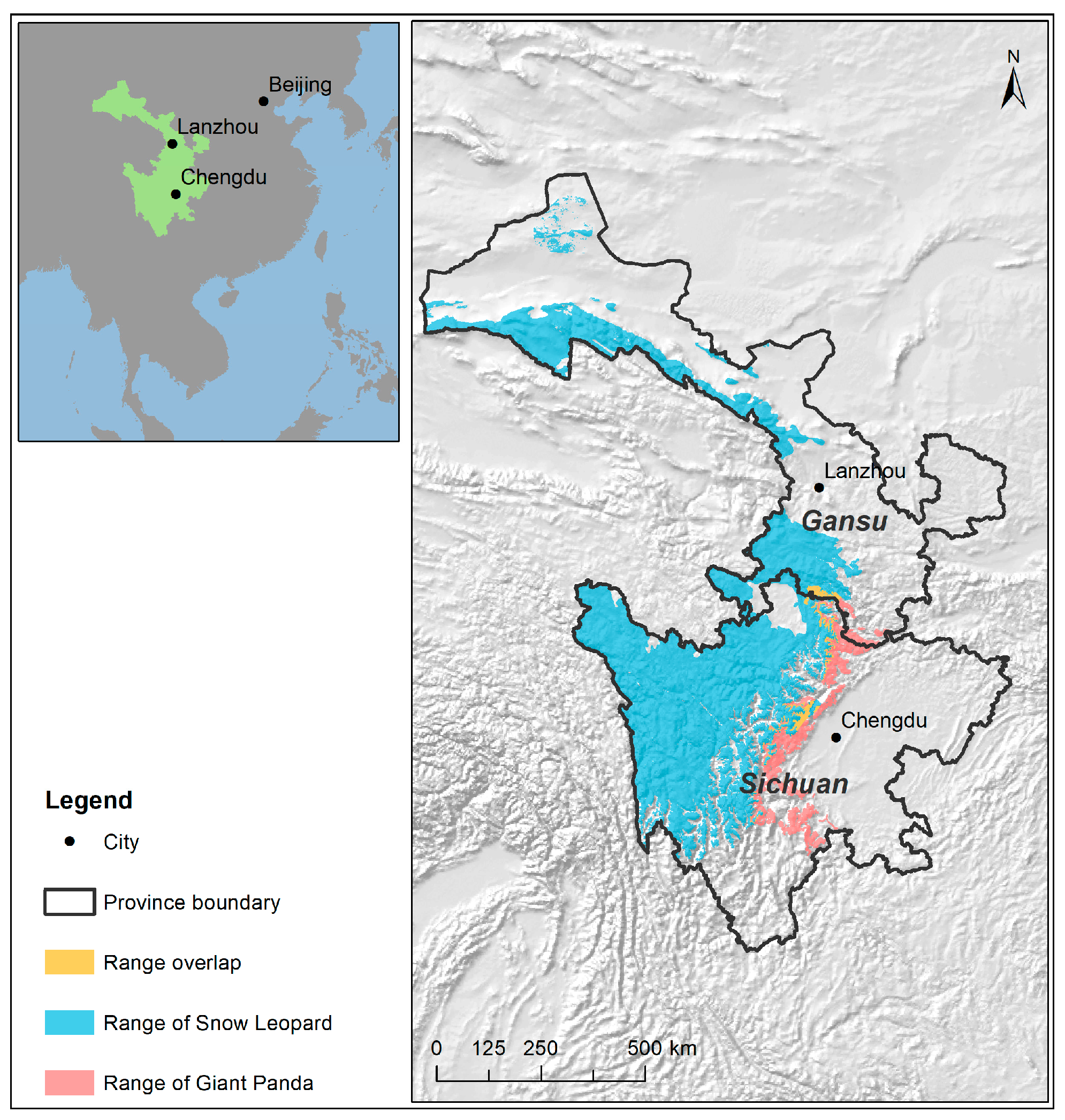
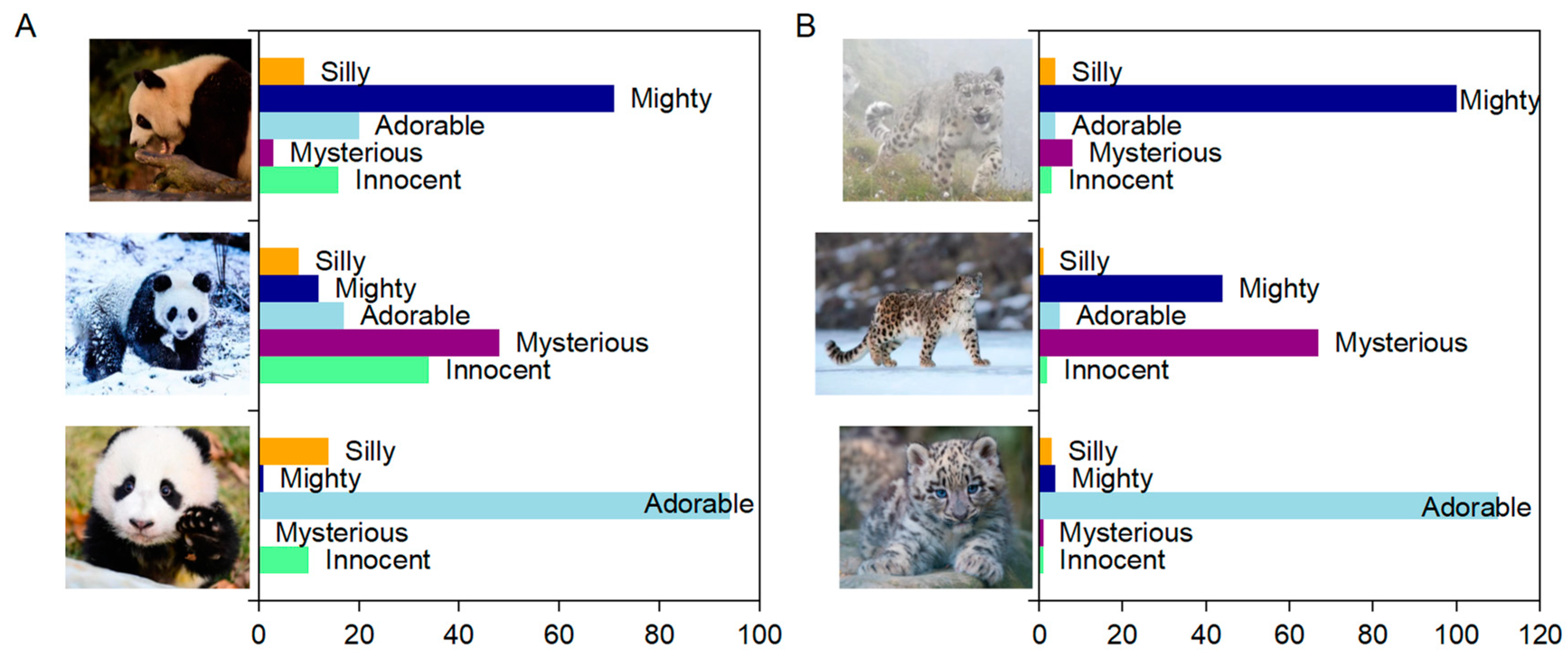
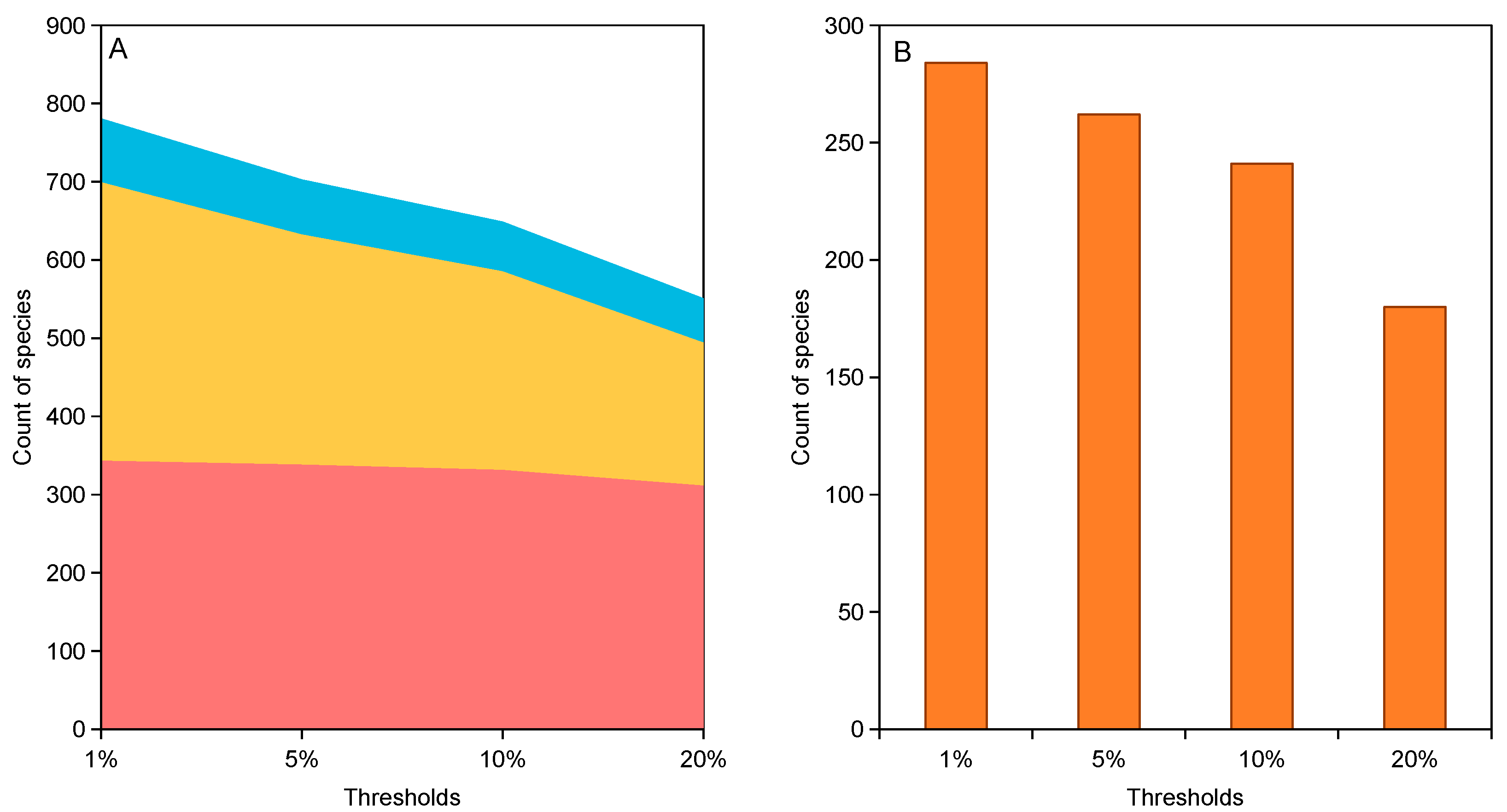
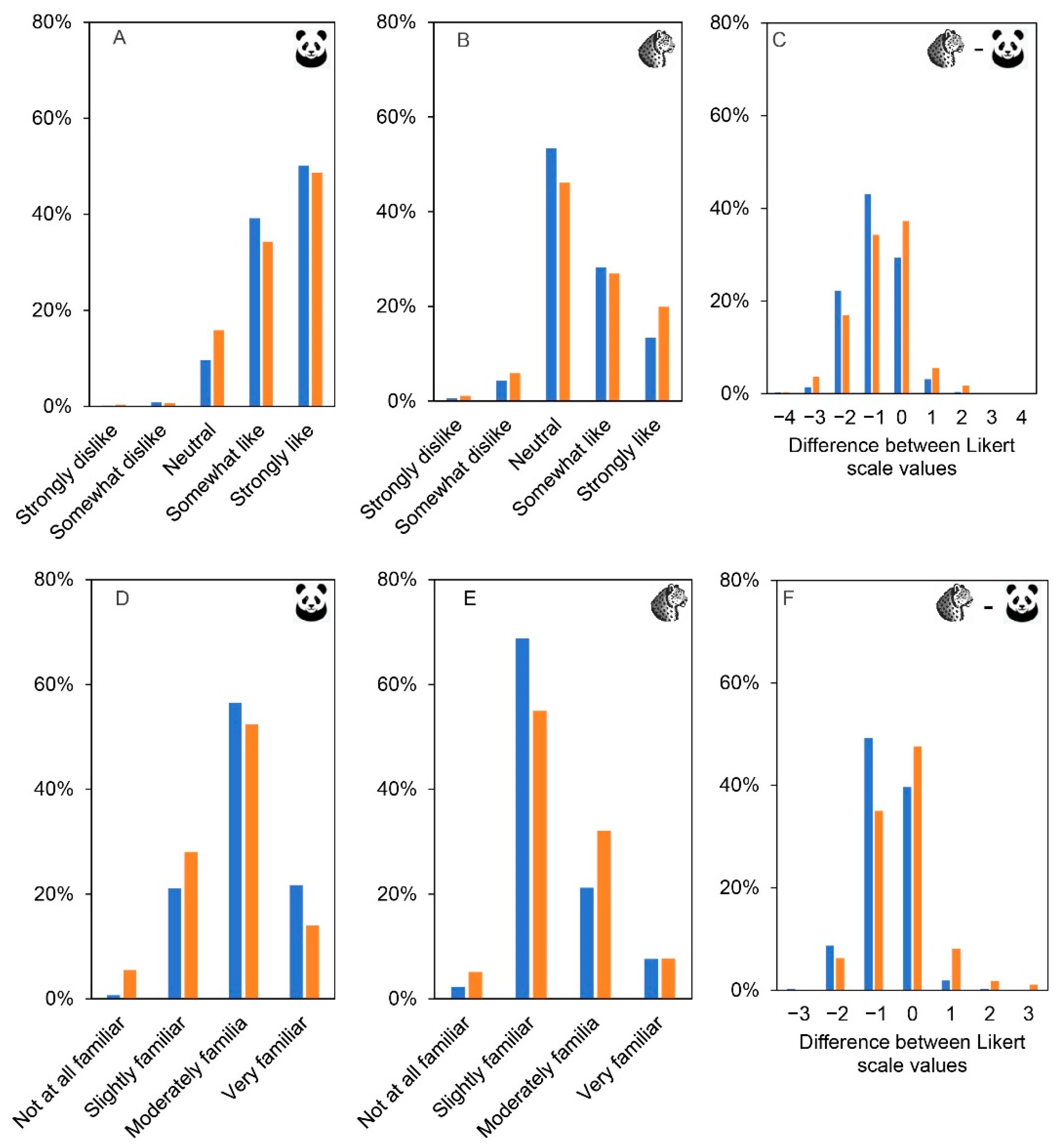
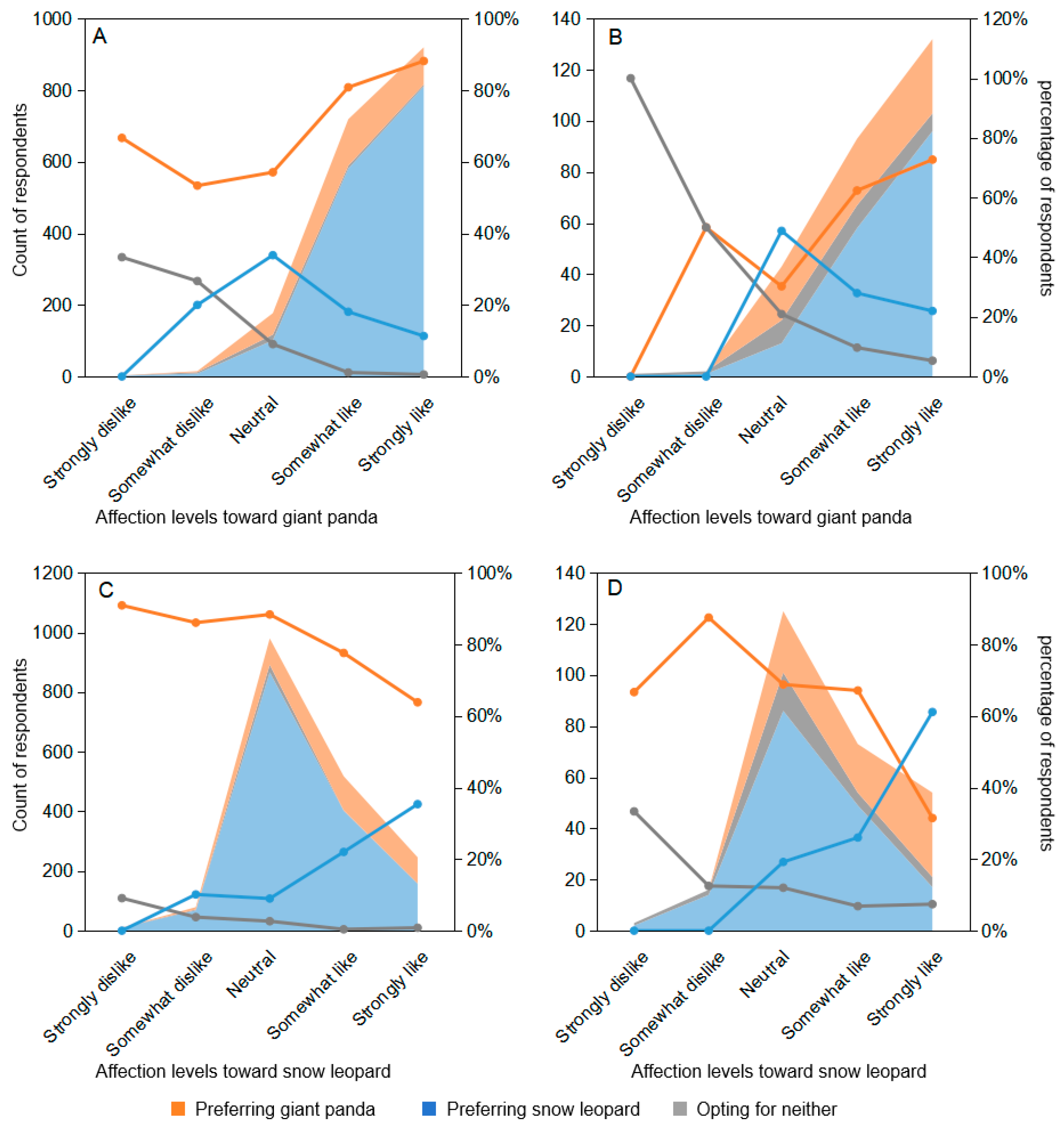
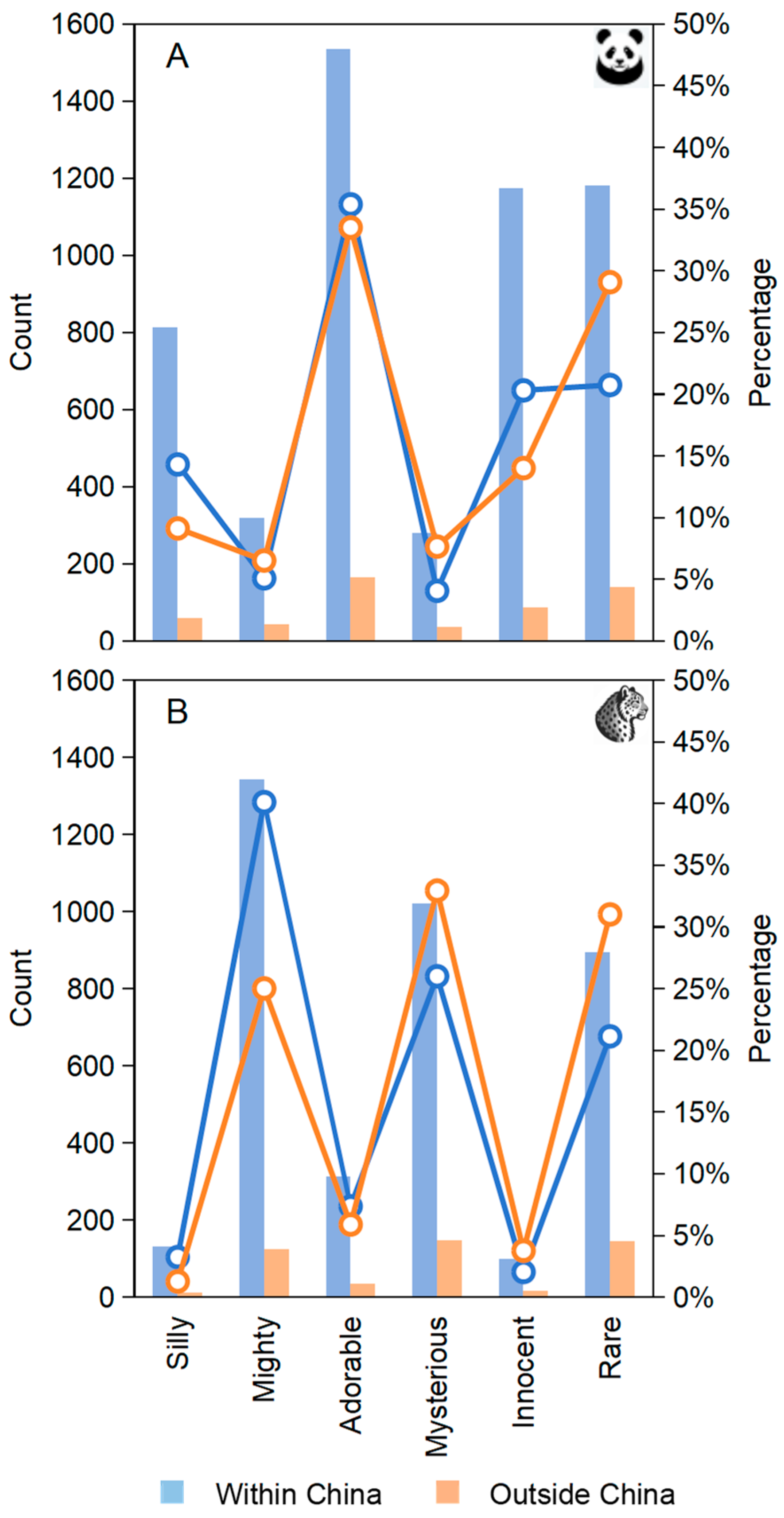
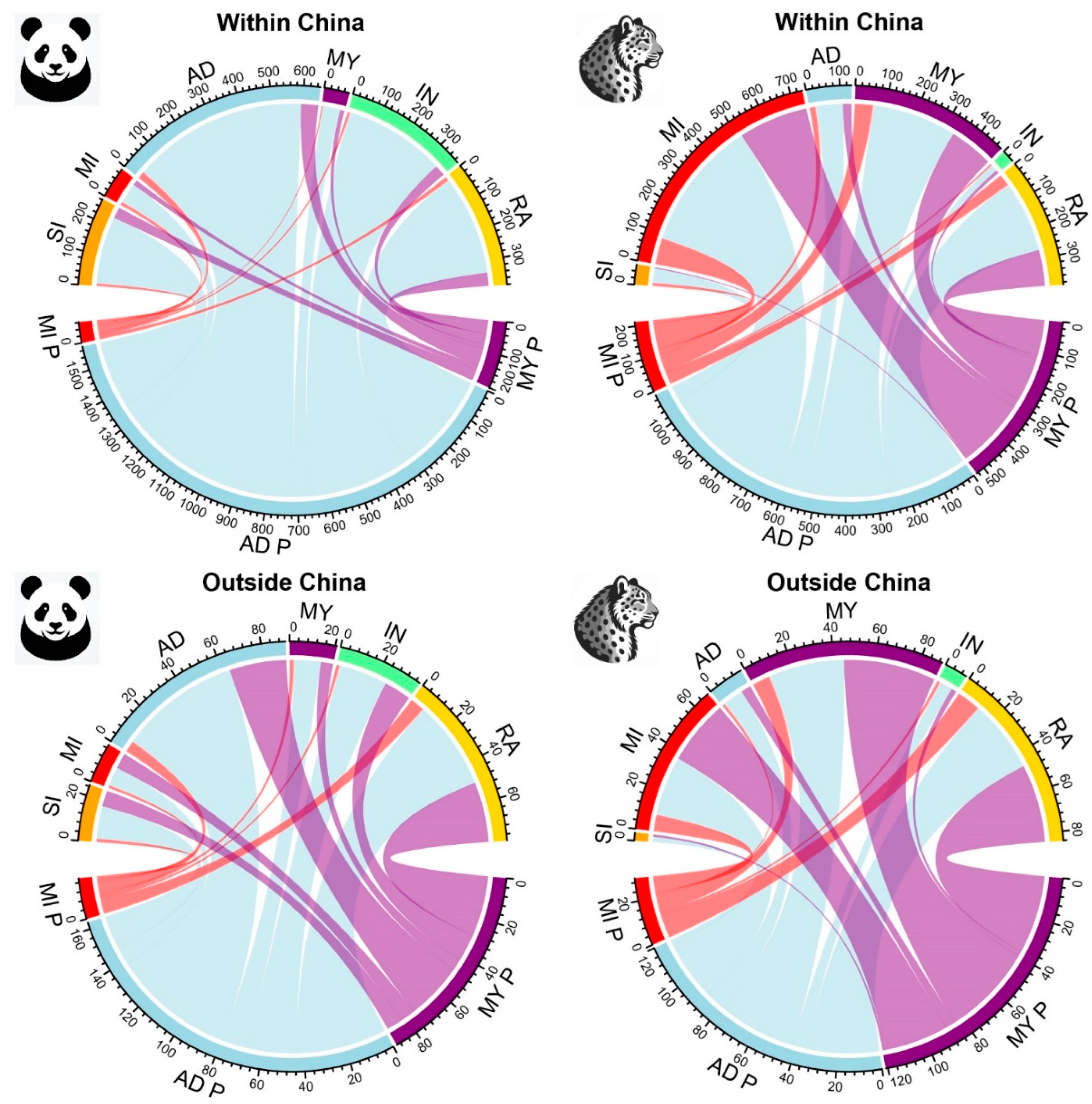
| Characteristics of Respondents | Count of Respondents | |
|---|---|---|
| Within China | Outside China | |
| Gender | ||
| Female | 1080 (58.89%) | 138 (50.92%) |
| Male | 754 (41.11%) | 129 (47.60%) |
| Prefer not to say | 0 (0%) | 4 (1.48%) |
| Age | ||
| 6–9 years | 13 (0.71%) | 27 (9.96%) |
| 10–14 years | 26 (1.42%) | 29 (10.70%) |
| 15–25 years | 647 (35.28%) | 37 (13.65%) |
| 26–35 years | 660 (35.99%) | 46 (16.97%) |
| 36–45 years | 221 (12.05%) | 64 (23.62%) |
| 46–55 years | 200 (10.91%) | 41 (15.13%) |
| 55+ years | 67 (3.65%) | 27 (9.96%) |
| Education | ||
| Primary School | 44 (2.40%) | 48 (17.71%) |
| Secondary School | 173 (9.43%) | 26 (9.59%) |
| Post Secondary/High School | 171 (9.32%) | 32 (11.81%) |
| University/Undergraduate | 1005 (54.80%) | 54 (19.93%) |
| University Graduate | 441 (24.05%) | 111 (40.96%) |
| B | SE | Z | P | |
|---|---|---|---|---|
| Within China | ||||
| Giant panda | ||||
| Gender: male | −0.1031 | 0.0964 | −1.0700 | 0.2848 |
| Age | 0.1081 | 0.0447 | 2.4200 | 0.0155 * |
| Education | 0.0590 | 0.0541 | 1.0920 | 0.2750 |
| Familiarity | 1.3971 | 0.0811 | 17.233 | <0.0001 ** |
| Snow leopard | ||||
| Gender: male | 0.3262 | 0.0984 | 3.3140 | <0.0001 ** |
| Age | 0.0444 | 0.0442 | 1.0050 | 0.3151 |
| Education | 0.0043 | 0.0547 | 0.0780 | 0.9377 |
| Familiarity | 2.1549 | 0.0905 | 23.821 | <0.0001 ** |
| Outside China | ||||
| Giant panda | ||||
| Gender: male | −0.3548 | 0.2505 | −1.4161 | 0.1568 |
| Gender: PNS | −1.3405 | 0.9860 | −1.3595 | 0.1740 |
| Age | −0.1151 | 0.1007 | −1.1429 | 0.2531 |
| Education | 0.0810 | 0.1211 | 0.6691 | 0.5034 |
| Familiarity | 1.0707 | 0.1793 | 5.9723 | <0.0001 ** |
| Snow leopard | ||||
| Gender: male | −0.0178 | 0.2472 | −0.0720 | 0.9426 |
| Gender: PNS | 0.9362 | 1.1358 | 0.8243 | 0.4098 |
| Age | −0.0215 | 0.1026 | −0.2092 | 0.8343 |
| Education | −0.0967 | 0.1190 | −0.8125 | 0.4165 |
| Familiarity | 1.2714 | 0.1888 | 6.7358 | <0.0001 ** |
| B | SE | Z | P | |
|---|---|---|---|---|
| Within China | ||||
| Gender: male | 0.5846 | 0.1287 | 4.5440 | <0.0001 ** |
| Age | −0.2388 | 0.0625 | −3.8180 | 0.0001 ** |
| Education | 0.1077 | 0.0732 | 1.4700 | 0.1414 |
| Outside China | ||||
| Gender: male | 0.6063 | 0.2966 | 2.044 | 0.0409 * |
| Gender: PNS | 27.24 | 264,700 | 0 | 0.9999 |
| Age | −0.2645 | 0.13 | −2.035 | 0.0419 * |
| Education | −0.06705 | 0.1439 | −0.466 | 0.6412 |
Disclaimer/Publisher’s Note: The statements, opinions and data contained in all publications are solely those of the individual author(s) and contributor(s) and not of MDPI and/or the editor(s). MDPI and/or the editor(s) disclaim responsibility for any injury to people or property resulting from any ideas, methods, instructions or products referred to in the content. |
© 2024 by the authors. Licensee MDPI, Basel, Switzerland. This article is an open access article distributed under the terms and conditions of the Creative Commons Attribution (CC BY) license (https://creativecommons.org/licenses/by/4.0/).
Share and Cite
Yue, Y.; Wang, Y.; Ye, Z.; Zhang, C.; Qiu, L.; Xu, Q.; He, X.; Ma, C.; Yang, B.; Yang, Z.; et al. Ecological and Public Advantages of a Dual Flagship Strategy: Giant Panda and Snow Leopard. Diversity 2024, 16, 76. https://doi.org/10.3390/d16020076
Yue Y, Wang Y, Ye Z, Zhang C, Qiu L, Xu Q, He X, Ma C, Yang B, Yang Z, et al. Ecological and Public Advantages of a Dual Flagship Strategy: Giant Panda and Snow Leopard. Diversity. 2024; 16(2):76. https://doi.org/10.3390/d16020076
Chicago/Turabian StyleYue, Ying, Yihong Wang, Ziyi Ye, Chengcheng Zhang, Lan Qiu, Qiang Xu, Xin He, Chendi Ma, Biao Yang, Zhisong Yang, and et al. 2024. "Ecological and Public Advantages of a Dual Flagship Strategy: Giant Panda and Snow Leopard" Diversity 16, no. 2: 76. https://doi.org/10.3390/d16020076
APA StyleYue, Y., Wang, Y., Ye, Z., Zhang, C., Qiu, L., Xu, Q., He, X., Ma, C., Yang, B., Yang, Z., & Dai, Q. (2024). Ecological and Public Advantages of a Dual Flagship Strategy: Giant Panda and Snow Leopard. Diversity, 16(2), 76. https://doi.org/10.3390/d16020076







